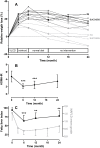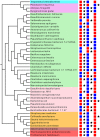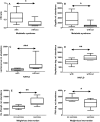Characterization of the Gut Microbial Community of Obese Patients Following a Weight-Loss Intervention Using Whole Metagenome Shotgun Sequencing
- PMID: 26919743
- PMCID: PMC4769288
- DOI: 10.1371/journal.pone.0149564
Characterization of the Gut Microbial Community of Obese Patients Following a Weight-Loss Intervention Using Whole Metagenome Shotgun Sequencing
Abstract
Background/objectives: Cross-sectional studies suggested that obesity is promoted by the gut microbiota. However, longitudinal data on taxonomic and functional changes in the gut microbiota of obese patients are scarce. The aim of this work is to study microbiota changes in the course of weight loss therapy and the following year in obese individuals with or without co-morbidities, and to asses a possible predictive value of the gut microbiota with regard to weight loss maintenance.
Subjects/methods: Sixteen adult patients, who followed a 52-week weight-loss program comprising low calorie diet, exercise and behavioral therapy, were selected according to their weight-loss course. Over two years, anthropometric and metabolic parameters were assessed and microbiota from stool samples was functionally and taxonomically analyzed using DNA shotgun sequencing.
Results: Overall the microbiota responded to the dietetic and lifestyle intervention but tended to return to the initial situation both at the taxonomical and functional level at the end of the intervention after one year, except for an increase in Akkermansia abundance which remained stable over two years (12.7x103 counts, 95%CI: 322-25100 at month 0; 141x103 counts, 95%CI: 49-233x103 at month 24; p = 0.005). The Firmicutes/Bacteroidetes ratio was higher in obese subjects with metabolic syndrome (0.64, 95%CI: 0.34-0.95) than in the "healthy obese" (0.27, 95%CI: 0.08-0.45, p = 0.04). Participants, who succeeded in losing their weight consistently over the two years, had at baseline a microbiota enriched in Alistipes, Pseudoflavonifractor and enzymes of the oxidative phosphorylation pathway compared to patients who were less successful in weight reduction.
Conclusions: Successful weight reduction in the obese is accompanied with increased Akkermansia numbers in feces. Metabolic co-morbidities are associated with a higher Firmicutes/Bacteroidetes ratio. Most interestingly, microbiota differences might allow discrimination between successful and unsuccessful weight loss prior to intervention.
Conflict of interest statement
Figures





References
-
- Despres J, Lemieux I. Abdominal obesity and metabolic syndrome. Nature 2006; 444: 881–887. - PubMed
-
- Ley RE, Turnbaugh PJ, Klein S, Gordon JI. Microbial ecology: human gut microbes associated with obesity. Nature 2006; 444: 1022–1023. - PubMed
-
- Turnbaugh PJ, Ley RE, Mahowald MA, Magrini V, Mardis ER, Gordon JI. An obesity-associated gut microbiome with increased capacity for energy harvest. Nature 2006; 444: 1027–1031. - PubMed
MeSH terms
LinkOut - more resources
Full Text Sources
Other Literature Sources
Medical

